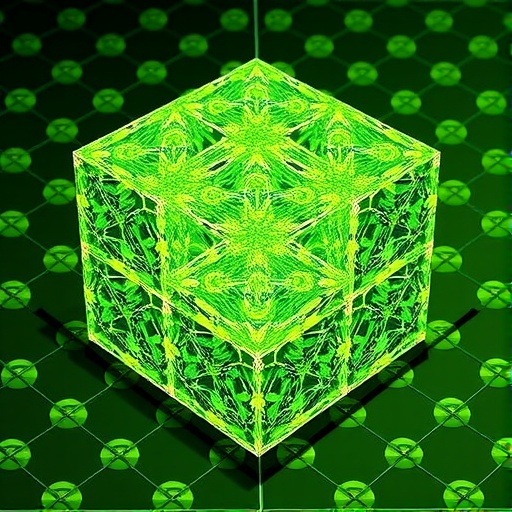In a groundbreaking study published in the journal “Ionics,” researchers have delved into the intricate world of crystallographic modulation and defect dynamics within isovalent Zn-Doped CuO. This study, helmed by Prachakiew, Boonphan, and Keereeta alongside their team, reveals critical insights that could reshape our understanding of material science. Copper oxide is known for its unique properties; however, its behavior under various conditions remains less understood. By examining doping techniques and their implications at a microscopic level, this research shines a light on the underlying mechanisms of defect formation and stability.
The researchers employed advanced synthesis methods to achieve precise Zn doping in CuO matrices. The meticulous doping process allowed the team to explore the effects of varying Zn concentrations on the crystalline structure of the material. Crystallographic modulation is essential as it dictates the material’s electronic properties. The introduction of zinc creates a substitutional defect that modifies the host lattice dynamics. This relationship between doping and structural modifications is not merely academic; it has far-reaching implications for the development of electronic devices that rely on optimized material properties.
Diving deeper into defect dynamics, the researchers examined how energy transitions within the material occur. They employed sophisticated spectroscopic techniques to track these dynamics under various excitation conditions. The dual excitation mechanisms identified within the study suggest a complex interplay between intrinsic and extrinsic factors influencing defect behavior. These findings challenge existing models of defect dynamics and present a more nuanced view, revealing how energy states interact differently based on external conditions.
One of the most compelling aspects of this research is the observation of temperature-dependent behaviors in the doped CuO. Such insights are pivotal as they inform the stability and performance of materials in real-world applications. This temperature sensitivity indicates that the electronic properties of Zn-doped CuO can be finely tuned by manipulating both the concentration of the dopant and the thermal environment. The concept of defect dynamics here transforms from a theoretical construct into a tangible variable that can be controlled in practical applications.
Moreover, the study considers the long-term stability and reliability of Zn-doped CuO in electronic components. Understanding the lifespan and degradation pathways of these materials is crucial for manufacturers aiming to create durable and reliable devices. As technology increasingly relies on materials that can sustain performance over time, the findings from this research provide essential data to inform future material engineering.
In addition to its implications in electronics, the findings also suggest potential applications in solar energy technologies. The ability to manipulate defect dynamics means that Zn-doped CuO could serve as an efficient photocatalyst. Such applications hinge on the material’s ability to absorb and efficiently convert sunlight into usable energy forms. This dual focus on defect dynamics and structural modulation paves the way for exciting developments in alternative energy sources.
Equally significant is the collaborative approach taken by the research team in this project. By drawing upon interdisciplinary perspectives—combining insights from chemistry, physics, and materials science—the researchers have created a rich tapestry of knowledge. This methodology not only enhances the reliability of the findings but also sets a precedent for future studies seeking to tackle complex problems within materials science.
The implications of this research extend beyond the immediate scientific community. As industries grapple with the demand for more efficient and sustainable materials, the insights gained here become vital benchmarks. Moreover, this research could inspire further studies into other transition metal oxides, unlocking doors to new possibilities in material engineering.
In the realm of academia, sharing such findings encourages dialogue and collaboration. With the publication of their work, the authors have opened the floor for discussions, critiques, and further investigations. The beauty of scientific research lies in its collaborative nature—every new discovery prompts further exploration and questioning.
As we stand on the brink of new technological advancements, the relationship between defects and material properties is increasingly becoming the focal point of innovation. This research exemplifies how minute changes at the atomic level can lead to substantial transformations in a material’s functionality. With continued exploration, there is great potential for developing tailored materials that meet the evolving demands of various industries.
Furthermore, this study serves as a reminder of the complexities inherent in material design. It is not enough to simply identify a suitable combination of elements; understanding how these elements interact on a structural and electronic level is essential for optimizing performance. Comprehensive studies like this one serve as foundational pillars that other researchers can build upon.
In conclusion, Prachakiew and colleagues have ushered in a new understanding of Zn-doped CuO, highlighting the importance of crystallographic modulation and defect dynamics. Their findings have far-reaching implications not just for the field of material science but for various applications across technology sectors. The interplay of defects and doping within materials introduces an exciting landscape for innovations, encouraging future research to expand on these principles and explore new territories.
As scientists continue to investigate the microscopic world, the importance of interdisciplinary collaborations becomes increasingly evident. Each study contributes to an overarching narrative about material functionalities and their potential applications in our society. The potential of Zn-doped CuO and other similar materials remains boundless, and as we delve deeper, who knows what new discoveries await?
Subject of Research: Crystallographic modulation and dual excitation-dependent defect dynamics in isovalent Zn-Doped CuO.
Article Title: Crystallographic modulation and dual excitation-dependent defect dynamics in isovalent Zn-Doped CuO.
Article References: Prachakiew, S., Boonphan, S., Keereeta, Y. et al. Crystallographic modulation and dual excitation-dependent defect dynamics in isovalent Zn-Doped CuO. Ionics (2025). https://doi.org/10.1007/s11581-025-06685-4
Image Credits: AI Generated
DOI: https://doi.org/10.1007/s11581-025-06685-4
Keywords: Zn-Doped CuO, crystallographic modulation, defect dynamics, electronic properties, material engineering, photocatalysis, temperature dependence.




